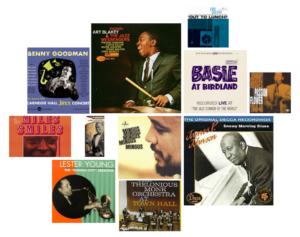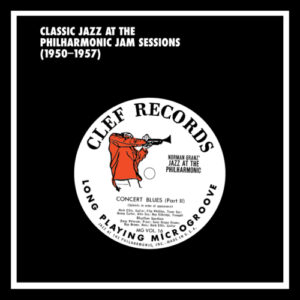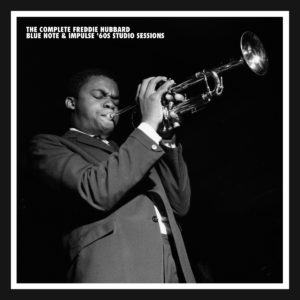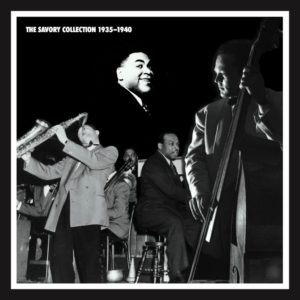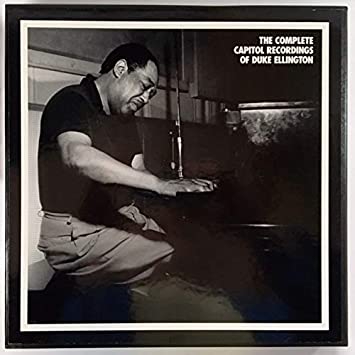
The Columbia Recordings Of Miles Davis With John Coltrane
Kind Of Blue Sessions
The Complete Columbia Recordings Of Miles Davis With John Coltrane
By Bob Blumenthal
The Miles Davis Quintet that took shape in late 1955 was built primarily around the relationship between Davis and drummer Joseph Rudolph “Philly Joe” Jones, a running buddy who often hit the road with Davis for gigs, while the rest of the band was drawn from local players. Paul Chambers, the young bass player from Detroit, had been recommended by Jackie McLean, who was working with Chambers at the time in pianist George Wallington’s band; but it was Jones who had introduced Davis to pianist Red Garland in 1953 and Jones who ultimately suggested Coltrane.
Miles Davis’ knowledge regarding Coltrane at that point centered around a session several years earlier at the Audubon Ballroom, where the young saxophonist had been clearly outclassed by Rollins. Somebody had to fill the open slot, though, so Coltrane started to rehearse with the new group.
For John Coltrane, this was the biggest break yet in what had been a low-profile career. Coltrane had started on alto sax, then switched to tenor in 1947 when he joined the band of blues singer and alto saxophonist Eddie “Cleanhead” Vinson. Coltrane and his friend Jimmy Heath then joined Dizzy Gillespie’s big band as alto players in 1949, though each returned to tenor in subsequent separate stays with Gillespie’s small group.
Coltrane was an undistinguished journeyman with what was generally considered an abrasive tone and odd, angular ideas. “I wasn’t excited,” Davis admitted in his autobiography; yet, in the next breath, he reports, “Faster than I could imagine, the music that we were playing together was just unbelievable.”
Miles Davis and John Coltrane would continue to make unbelievable music together, on and off, for the rest of the decade. They did not hang out together after the gig—“All Coltrane lived for was to play music,” noted the far more worldly Davis. As a recovered addict, Davis also became so disgusted with the way drugs were affecting Coltrane that he fired the saxophonist at the end of 1956.
Yet Davis was fascinated by Coltrane’s daring conception, and recognized that his tenor provided the ideal contrast to his own playing. Coltrane for his part considered Davis a musical pioneer, and appreciated the freedom inherent in his boss’ evolving approach. After confronting his drug problem the way Davis had, by going home and toughing it out with the support of his family, Coltrane ultimately returned to the band.
Ambitious orchestral projects with Gil Evans were also part of Davis’ creative life in this period, which explains why the Davis/Coltrane team was heard on a relatively few Columbia albums. Their efforts yielded only three complete studio albums for the label— ‘Round About Midnight, Milestones and Kind Of Blue—plus one side of Jazz Track and (in a reunion after Coltrane had formed his own band) two tracks on Someday My Prince Will Come. Forty years on, this is the music you find when you look up “jazz” in the dictionary.
Kind of Blue Sessions
March 2 and April 22, 1959
March 2, 1959
Kelly was the band’s pianist when Kind Of Blue was recorded in March and April of 1959, yet he only plays on one of the five tracks. “I had already planned that album around the piano playing of Bill Evans,” explained Davis, who was eager to extend the modal explorations he had begun with Milestones. Prompted by Evans, Davis had investigated how European composers such as Ravel, Rachmaninoff and Khachaturian employed scales in their compositions.
He had another goal in mind with this album, a recreation of the rural black religious music that Davis heard as a child on visits to Arkansas. To the extent that Kind Of Blue does not convey this feeling, he felt the album less than a total success. Everyone else considers it one of the masterpieces of all recorded music.
Each of the three tracks recorded on March 2 features distinct personnel. Freddie Freeloader, was by the then-current Sextet and gives Kelly great prominence. He plays fills around the spare, melancholy “amen” theme and takes the first solo, working his way into a second chorus on the previously unissued false start before Davis stops the proceedings and asks Kelly to omit chords at a specific modulation.
The melody, like Sid’s Ahead, is an example of simplicity in the service of complex emotions; and Kelly’s effervescent contributions convey an optimism that only highlights Evans’ more brooding contributions elsewhere on the album. Davis had been a master of altered blues progressions at least since he recorded Sippin’ At Bells in 1947, and he makes poetic use of the substitute changes at the end of each chorus. Coltrane and Adderley in their turn show how to make a saxophone cry while playing cliché-free blues. Both have gained richness in their tone and an even more refined balance to their lines since the band’s last studio recording. Paul Chambers concludes the soloing, with perky goading from Kelly.
Bill Evans takes over for So What, which remains the most influential track from this most influential album and one of only two that became a permanent part of the Miles Davis repertoire. It is a 32-bar, AABA structure, built on two Dorian modes rather than a more detailed chord sequence. Ahmad Jamal had included the same modal progression in his 1955 recording of Morton Gould’s Pavanne, in support of a melodic line that later became Coltrane’s Impressions. Jamal did not improvise on the modes, however. Once musicians grew accustomed to blowing over this open terrain, So What became the I Got Rhythm of modal jazz.
It is introduced here by piano and bass, playing the only detailed written material employed at the session which has been attributed to both Gil Evans (the more likely source) and Bill Evans. Chambers states the melody, with responses by Evans and the horns. The two-note kicker is another “amen” cadence that gets at the church-music echoes Davis wanted in the music, although the interval creates a far different feeling here than on Freddie Freeloader. Each soloist confronts the challenge of blowing over modes brilliantly; and each horn soloist draws distinct accompanying textures from Evans. The horns riff behind the piano solo, as Evans responds with complex chord voicings on the bridge of his chorus.
As the original liner notes put it, “Julian Adderley lays out on Blue In Green,” the composition for which Evans specifically claimed a composing credit. As he explained to Conrad Silvert, “One day at Miles’ apartment, he wrote on some manuscript paper the symbols for G-minor and A-augmented. And he said, ‘What would you do with that?’ I didn’t really know, but I went home and wrote Blue In Green.” The piece does recall ideas Evans used on the introduction to Alone Together from a Chet Baker session recorded two months earlier. Evans starts and ends Blue In Green, playing a four-bar introduction and bringing the track to a close with a restatement of the theme over bowed bass.
In between is a unique structure that Evans described in the original liner notes as “a ten-measure circular form…played by soloists in various augmentation and diminution of time values.” The pyramid ordering of the solos is further enhanced by the way Evans suggests acceleration in his first full chorus, then plays in a more pronounced double-time before Davis returns. The eloquence of Evans, Coltrane and especially Davis on such challenging material yields a supremely beautiful musical statement.
April 22, 1959
Back in the studio, the Sextet with Evans once again on piano recorded two more titles to complete Kind Of Blue.
Flamenco Sketches was the most open and challenging form of the lot—“a series of five scales, each to be played as long as the soloist wishes until he has completed the series,” as Evans explained in the original liner notes. While each was free to blow as long as he wished on the individual scales, the solos fall into the symmetries of four-bar and eight-bar inventions, although Davis tries to break the mold in his opening chorus when he pauses and then quickly modulates to the fourth scale in the middle of a four-bar phrase.
By the master, which is noted as Take 6 on the session logs, the tempo has grown firmer, Chambers is taking a more decorative approach, and the soloists have gained enough confidence to extend different scales in their improvisations. The tolling, see-saw motion of the master recalls the classic Evans improvisation Peace Piece from the pianist’s December 1958 album Everybody Digs Bill Evans, although the mood of Flamenco Sketches is decidedly more optimistic.
All Blues, which would acquire an effective lyric by Oscar Brown, Jr., is a blues that Davis originally conceived in 4/4, then turned into a waltz at the studio. It is one of the most dramatic performances in his discography, with a simple, yet startling, arrangement that begins with Cobb’s brushes, a bass vamp from Chambers, trills from Evans, a harmonized saxophone riff that recalls the melody of Milestones, and the leader’s Harmon-muted horn playing melody over and then through the saxes.
Tension is heightened rather than resolved as Davis removes his mute, with Cobb switching to sticks and Evans beginning a track-long expansion of the sax riff behind the soloists, and the entire performance sustains suspense as the rhythm section adjusts to each soloist. Cobb, typically masterful without calling attention to himself, sounds like a thoroughbred waiting for the starting gun as he anticipates Coltrane’s entrance. His rim-shots behind Evans connect the atmospheric piano solo to many of Red Garland’s more groove-oriented statements.
Each of the four soloists is at his best, bringing deep emotion to their statements without shattering the tender mood. This piece stayed in the Davis book for several years, although it (and So What) grew faster over time.
Discography
Because of the voluminous amount of reissues and compilations using this material, only the first issue of each master is given.
________________________________________________________________
(A) Miles Davis (trumpet), John Coltrane (tenor saxophone), Red Garland (piano), Paul Chambers (bass), Philly Joe Jones (drums).
Wednesday, October 26, 1955 (3:30 to 8:30 pm)
Columbia Studio D, NYC
Producer: George Avakian. Recording engineer: Frank Laico
co54129-1 Two Bass Hit (alternate take) previously unissued
co54129-2/5 Two Bass Hit KC2-36278
(take 2 through most of tenor solo, then take 5)
co54130-1 Ah-Leu-Cha (alternate take) previously unissued
co54130-5/4 Ah-Leu-Cha CL 949
(take 5 to middle of trumpet solo, then take 4)
co54130-5 Ah-Leu-Cha (alternate take) previously unissued
co54132-2/3 Little Melonae C 32025
(take 2 to middle of trumpet solo, then take 3 to end)
co54133-1 Budo (alternate take) C5X-45000
co54133-8 Budo CL 1020
(take 8 includes some theme ensemble edits from take 1 or 2)
Note: Most discographies and album credits date this session as October 27, but it took place the day before. An unissued version of “Billy Boy” (co54131) from this session does not include Davis or Coltrane and is not included here.
________________________________________________________________
(B) Miles Davis (trumpet), John Coltrane (tenor saxophone), Red Garland (piano), Paul Chambers (bass), Philly Joe Jones (drums).
Tuesday, June 5, 1956 (5 to 9 pm)
Columbia 30th Street Studio, NYC
Producer: George Avakian. Recording engineer: Frank Laico
co56090-1 Dear Old Stockholm CL 949
co56091-1 Bye Bye Blackbird (alternate take) previously unissued
co56091-3 Bye Bye Blackbird CL 949
co56092-2 Tadd’s Delight CL 949
co56092-5 Tadd’s Delight (alternate take) previously unissued
co56090-5 Dear Old Stockholm (alternate take) previously unissued
_________________________________________________________________
(C) Miles Davis (trumpet), John Coltrane (tenor saxophone), Red Garland (piano), Paul Chambers (bass), Philly Joe Jones (drums).
Monday, September 10, 1956 (5 to 8 pm)
Columbia 30th Street Studio, NYC
Producer: George Avakian. Recording engineer: Frank Laico
co56584-1 All Of You (alternate take) previously unissued
co56584-2 All Of You CL 949
co56585-1 Sweet Sue, Just You (first version) previously unissued
co56585-3 Sweet Sue, Just You (false start with discussion
between Leonard Bernstein and Miles Davis) previously unissued
co56585-5 Sweet Sue, Just You (alternate take) previously unissued
co56585-8 Sweet Sue, Just You CL 919
Miles Davis comments previously unissued
co56586-1 ‘Round Midnight CL 949
note: The introduction to “Sweet Sue, Just You” was arranged by Teo Macero. “‘Round Midnight” was most likely arranged by Gil Evans.
__________________________________________________________________
(D) Miles Davis (trumpet), Cannonball Adderley (alto saxophone), John Coltrane (tenor saxophone), Red Garland (piano), Paul Chambers (bass), Philly Joe Jones (drums).
Tuesday, February 4, 1958 (2 to 6:30 pm)
Columbia 30th Street Studio, NYC
Producer: George Avakian. Recording engineer: Harold Chapman
co60199-1 Two Bass Hit (alternate take) previously unissued
co60199-2 Two Bass Hit CL 1193
co60200-1 Billy Boy (trio only) CL 1193
co60201-1 Straight No Chaser (alternate take) previously unissued
co60201-2 Straight No Chaser CL 1193
cl60202-2 Milestones (alternate take) previously unissued
co60202-3 Milestones CL 1193
note: “Milestones” appeared as “Miles” on CL 1193.
__________________________________________________________________
(E) Miles Davis (trumpet), Cannonball Adderley (alto saxophone), John Coltrane (tenor saxophone), Red Garland (piano), Paul Chambers (bass), Philly Joe Jones (drums).
Tuesday, March 4, 1958 (7 to 10 pm)
Columbia 30th Street Studio, NYC
Producer: George Avakian. Recording engineer: Harold Chapman
co60204-1 Sid’s Ahead CL 1193
remake-3 Little Melonae (omit Adderley) previously unissued
co60203-2 Dr. Jackle CL 1193
note: Davis plays piano on portions of “Sid’s Ahead”. Red Garland who arrived late appears only on “Dr. Jackle” which was misidentified as “Dr. Jeckyll” on its original release.
The Japanese album “1958-Miles” includes the 1955 version of “Little Melonae”.
________________________________________________________________
(F) Miles Davis (trumpet), Cannonball Adderley (alto saxophone), John Coltrane (tenor saxophone), Bill Evans (piano), Paul Chambers (bass), Jimmy Cobb (drums).
Monday, May 26, 1958 (7 to 10 pm)
Columbia 30th Street Studio, NYC
Producer: Cal Lampley. Recording engineer: Harold Chapman
co61165-3 On Green Dolphin Street CL 1268
co61166-1 Fran-Dance (alternate take) previously unissued
co61166-2 Fran-Dance CL 1268
co61167-3/7 Stella By Starlight (omit Adderley) CL 1268
(take 3 up to tenor solo, then take 7)
co61168-1 Love For Sale PG 33402
note: “Fran-Dance” is Miles’s arrangement of the traditional “Put Your Little Foot Right Out”. On the original release (CL 1268), the tune bore Miles’s title on the LP label and the original title on the album jacket.
“Stella By Starlight” on the LP and CD release “’58 Sessions” (CJ/CK 47835) inadvertantly use the complete take 7 with a different (and inferior) intro and melody statement than the known composite master. It was decided not to repeat the mistake on this set.
________________________________________________________________
(G) Miles Davis (trumpet), Cannonball Adderley (alto saxophone), John Coltrane (tenor saxophone), Bill Evans (piano), Paul Chambers (bass), Jimmy Cobb (drums).
Thursday, July 3, 1958
Newport Jazz Festival, Newport, Rhode Island
Recording supervised by George Avakian. Original release produced by Teo Macero.
Recording engineers: Adjutor Theroux and Buddy Graham
co81844 Ah-Leu-Cha CL 2178
co81845 Straight No Chaser CL 2178
co81846 Fran-Dance CL 2178
co81847 Two Bass Hit CL 2178
Bye Bye Blackbird (omit Adderley) C2-38262
The Theme faded on C2-38262
note: The original LP issue misidentifies the pianist as Wynton Kelly.
________________________________________________________________
(H) Miles Davis (trumpet), Cannonball Adderley (alto saxophone), John Coltrane (tenor saxophone), Bill Evans (piano), Paul Chambers (bass),Jimmy Cobb (drums).
Tuesday, September 9, 1958 (6 to 7 pm)
Persian Room, Plaza Hotel, New York City
Produced by Teo Macero and Irving Townsend. Recording engineer: George Kneurr
co93314 If I Were A Bell (omit Adderley) PC32470
co93317 Oleo PC32470
My Funny Valentine (omit saxes) PC32470
Straight No Chaser PC32470
note: The original LP misidentifies the tune “Straight No Chaser” as “Jazz At The Plaza”, the drummer as Philly Joe Jones and the location as The Edwardian Room.
_________________________________________________________________
(I) Miles Davis (trumpet), Cannonball Adderley (alto saxophone), John Coltrane (tenor saxophone), Wynton Kelly-1, Bill Evans-2 (piano), Paul Chambers (bass), Jimmy Cobb (drums).
Monday, March 2, 1959 (2:30 to 5:30 and 7 to 10 pm)
Columbia 30th Street Studio, NYC
Producer: Irving Townsend. Recording engineer: Fred Plaut
co62290-3 Freddie Freeloader-1 (false start) previously unissued
co62290-4 Freddie Freeloader-1 CL1355
co62291-3 So What-2 CL1355
co62292-5 Blue In Green-2 (omit Adderley) CL1355
note: One of the three-track machines at this session was running slightly slow. The original album was mixed from the tape on that machine causing the originally issued masters to be slightly sharp. This was first corrected for the gold Mastersound CD edition of this album.
_________________________________________________________________
(J) Miles Davis (trumpet), Cannonball Adderley (alto saxophone), John Coltrane (tenor saxophone), Bill Evans (piano), Paul Chambers (bass),Jimmy Cobb (drums).
Wednesday, April 22, 1959 (2:30 to 5:30 pm)
Columbia 30th Street Studio, NYC
Producer: Irving Townsend. Recording engineer: Fred Plaut
co62293-1 Flamenco Sketches (alternate take) C5X45000
Miles Davis comments previously unissued
co62293-6 Flamenco Sketches CL1355
co62294-1 All Blues CL1355
_________________________________________________________________
(K) Miles Davis (trumpet), Hank Mobley, John Coltrane (tenor saxophone), Wynton Kelly (piano), Paul Chambers (bass),Jimmy Cobb (drums).
Monday, March 20, 1961 (3 to 5:30 pm)
Columbia 30th Street Studio, NYC
Producer: Teo Macero. Recording engineer: Frank Laico.
co66500-15 Someday My Prince Will Come CL 1656
note: John Coltrane does not appear on any other tunes from this session.
__________________________________________________________________
(L) Miles Davis (trumpet), John Coltrane (tenor saxophone), Wynton Kelly (piano), Paul Chambers (bass),Jimmy Cobb (drums).
Tuesday, March 21, 1961 (2:30 to 5:30 pm)
Columbia 30th Street Studio, NYC
Producer: Teo Macero. Recording engineer: Frank Laico.
co66505-9 Teo CL 1656
note: John Coltrane does not appear on any other tunes from this session.
__________________________________________________________________
Album Index
CL 919 What Is Jazz (rel. 10-15-56)
CL 949 Round About Midnight (rel. 3-4-57)
CL 1020 Jazz Omnibus (rel. 9-3-57)
CL 1193 Milestones (rel. 9-2-58)
CS 9428 Milestones (fake stereo – rel. 6-19-67)
CS 8649 Round About Midnight (fake stereo – rel. 8-13-62)
CL 1355/CS 8163 Kind Of Blue (rel. 8-17-59)
CL 1268 Jazz Track (rel. 10-19-59)
CL 1656/CS 8456 Someday My Prince Will Come (rel. 12-11-61)
CL 2178/CS 8978 Miles And Monk At Newport (rel. 5-11-64)
C 32025 Basic Miles (mono tracks in fake stereo, rel. 8-24-73)
C 32470 Jazz At The Plaza, Vol.1 (rel 9-28-73)
PG 33402 Black Giants (rel. 5-75)
KC2 36278 Circle In The Round (rel 11-79)
C2-38262 Newport Jazz Festival Live (rel. 10-82)
C5X45000 The Columbia Years 1955-1985 (rel. 1988)
Box set produced by Michael Cuscuna and Bob Belden
Executive producer: Charlie Lourie
Sessions A-C transferred from the original mono tapes and sessions D-L remixed from the original three-track tapes by Mark Wilder
Mastered by Kevin Hodge, Master Cutting Room
Special thanks to John Naatches, Jan Lohmann, Yasuhiro Fujioka, David Weiss, Dan Morganstern and the Institute Of Jazz Studies.
Design direction: Richard Mantel
Design production: InkWell, Inc.
©2000 Sony Music Entertainment Inc./(p)2000 Sony Music Entertainment Inc./ Manufactured by Sony Music Special Products., 550 Madison Avenue, New York, NY 122-3211/”Columbia” and “Sony” Reg. U.S. Patent & TM Office/Marca Registrada/WARNING All Rights Reserved. Unauthorized duplication is a violation of applicable laws.


